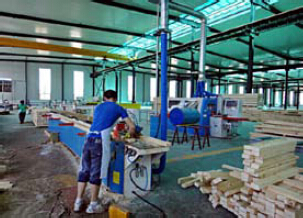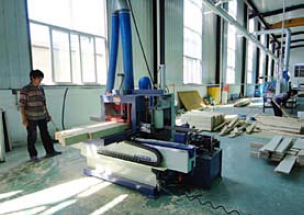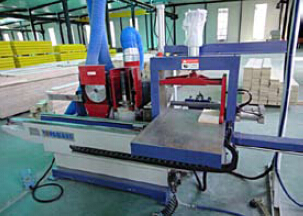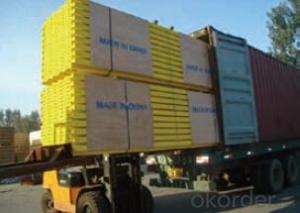Timber Beam H20 for formwork and scaffolding system
- Loading Port:
- Tianjin
- Payment Terms:
- TT OR LC
- Min Order Qty:
- 50 m²
- Supply Capability:
- 1000 m²/month
OKorder Service Pledge
Quality Product, Order Online Tracking, Timely Delivery
OKorder Financial Service
Credit Rating, Credit Services, Credit Purchasing
You Might Also Like
Characteristics:
◆ Standardized production lines.
Supply capability: 3000m/day, Lmax = 6600mm.
◆ Finger jointing of the flange and web, the strength of timber beam is highly improved.
Max. shearing force failure load:40KN
◆ Well treated to prevent from water penetration or erosion, so the service life maximally extended.
Normally, CNBM timber beam H20 can be used for 4 to 5 years, the exact using time would depend on maintenance & storage.
◆ Robust caps at the end of the girders protect against damages.




- Q:Can steel formwork be used for curved or irregularly shaped structures?
- Yes, steel formwork can be used for curved or irregularly shaped structures. Steel formwork is highly flexible and can be easily customized to match the desired shape or form of the structure. Its strength and durability make it suitable for various construction projects, including those that involve unique or unconventional designs.
- Q:Can steel formwork be used for airport construction projects?
- Certainly, airport construction projects can make use of steel formwork. Steel formwork proves to be a versatile and long-lasting option when it comes to building various concrete structures within airports. Its attributes such as high strength, stability, and reusability offer multiple advantages, making it a suitable choice for extensive projects like airport construction. The robustness of steel formwork enables it to withstand the immense loads and pressures associated with airport infrastructure, thereby facilitating the construction of runways, taxiways, aprons, and other essential structures. Moreover, its modular design and flexibility allow for effortless customization and adaptation to cater to diverse project requirements. In summary, steel formwork emerges as a dependable selection for airport construction projects due to its durability, strength, and adaptability.
- Q:Can steel formwork be used in renovation and refurbishment projects?
- Yes, steel formwork can be used in renovation and refurbishment projects. Steel formwork is versatile and durable, making it suitable for various construction applications, including renovations and refurbishments. It provides structural support and helps ensure precise and accurate concrete shaping during the renovation process. Additionally, steel formwork can be reused multiple times, making it cost-effective for projects that require frequent alterations or modifications.
- Q:Can steel formwork be used for energy-efficient concrete buildings?
- Yes, steel formwork can be used for energy-efficient concrete buildings. Steel formwork provides excellent strength and durability, allowing for the construction of complex concrete structures with high thermal performance. Additionally, steel formwork can be easily reused multiple times, reducing waste and promoting sustainability in the construction industry.
- Q:What are the different types of edge protections available for steel formwork?
- There are several types of edge protections available for steel formwork, including steel edge angles, timber edge fillets, plastic edge profiles, and rubber edge guards. These edge protections are used to ensure the safety of workers by preventing them from accidentally stepping off the edge of the formwork.
- Q:What are the safety precautions when working with steel formwork?
- To ensure the safety of workers when using steel formwork, it is important to adhere to specific safety measures. These measures encompass the following: 1. Comprehensive training: All workers must undergo thorough training on the proper usage of steel formwork. This entails understanding how to assemble, disassemble, and handle the formwork system. Additionally, workers should be trained to identify any potential risks or hazards associated with steel formwork. 2. Utilization of Personal Protective Equipment (PPE): Workers should consistently wear appropriate PPE, which typically consists of safety helmets, steel-toed boots, high-visibility vests, and gloves. Depending on the tasks involved, additional PPE such as safety glasses or respiratory protection may be necessary. 3. Secure and stable installation: Prior to commencing work, it is crucial to securely and stably install the steel formwork. This involves proper anchoring and bracing to prevent any movement or collapse during use. Regular checks should be conducted to ensure the formwork remains stable throughout the project. 4. Safe access and egress: Workers must have safe and unobstructed access to the steel formwork. This may require the installation of secure ladders, platforms, or scaffolding to provide a stable means of reaching the formwork. Adequate lighting should also be provided to enhance visibility and prevent accidents. 5. Regular inspections: Regular inspections of the steel formwork should be carried out to identify and address any signs of wear, damage, or deterioration. This includes checking for bent or damaged components, loose connections, or signs of corrosion. Prompt action should be taken to rectify any issues and maintain the integrity and safety of the formwork. 6. Proper lifting and handling techniques: When moving or lifting steel formwork components, workers should employ appropriate lifting techniques and equipment. This may involve the use of cranes, hoists, or forklifts, depending on the size and weight of the components. Adequate training and supervision should be provided to ensure adherence to safe lifting practices. 7. Effective communication: Clear communication among workers is paramount when working with steel formwork. This can be achieved through the use of hand signals, radios, or other communication devices to relay important information or warnings. Additionally, clear signage and barriers should be employed to indicate restricted areas or potential hazards. By adhering to these safety precautions when working with steel formwork, the risk of accidents, injuries, or structural failures can be significantly minimized, resulting in a safer working environment for all individuals involved.
- Q:Can steel formwork be used in seismic-prone areas?
- Yes, steel formwork can be used in seismic-prone areas. Steel formwork is known for its high strength and durability, making it suitable for use in areas with high seismic activity. It provides excellent resistance against the lateral forces generated during an earthquake, ensuring the structural integrity of the formwork system. Additionally, steel formwork offers flexibility in design and can be easily adjusted or modified to accommodate the specific requirements of seismic-prone areas. It is important, however, to ensure proper engineering and design considerations are applied when using steel formwork in these areas to ensure it meets the necessary safety standards and regulations.
- Q:Can steel formwork be used in underground structures?
- Underground structures can indeed utilize steel formwork. This material proves to be highly versatile and durable, capable of withstanding the demanding conditions underground. Its exceptional strength and stability make it ideal for constructing walls, columns, and slabs in subterranean spaces. One major advantage of steel formwork lies in its ability to resist the pressure exerted by the surrounding soil and water. Underground structures often encounter significant hydrostatic pressure, yet steel formwork remains resilient and free from deformation or collapse. This ensures the structure's safety and stability. Moreover, steel formwork is reusable, making it a cost-effective option for underground construction projects. Its robust nature allows for multiple uses, reducing the need for frequent replacements and lowering overall construction costs. Furthermore, steel formwork offers design flexibility, easily customizable to meet specific project requirements. It can be shaped and sized to create intricate geometries within underground structures. However, it is crucial to note that steel formwork necessitates proper surface treatment to safeguard against corrosion in the underground environment. Special coatings or galvanization can be applied to prevent rusting and extend the formwork's lifespan. In conclusion, steel formwork proves to be a suitable choice for underground structures due to its strength, durability, reusability, and design flexibility. It effectively withstands the challenges posed by the underground environment, guaranteeing long-term stability and safety for the structure.
- Q:What are the advantages and disadvantages of the application of the steel formwork and the plywood formwork in the construction?
- Economic aspect: the steel formwork one-time investment cost is high, but the turnover number is more; the wood template cost is low, but the turnover number is less
- Q:Can steel formwork be easily dismantled and removed after construction?
- Yes, steel formwork can be easily dismantled and removed after construction. Steel formwork is designed to be reusable and can withstand the weight and pressure of the concrete during the construction process. Once the concrete has cured and the construction is complete, the steel formwork can be easily dismantled using basic tools such as hammers and wrenches. The individual components of the steel formwork can be unbolted and removed from the concrete structure. The dismantled steel formwork can then be cleaned, inspected, and stored for future use, reducing the need for new formwork for future construction projects. Overall, the use of steel formwork offers the advantage of easy dismantling and removal, making it a cost-effective and sustainable option for construction projects.
1. Manufacturer Overview |
|
|---|---|
| Location | |
| Year Established | |
| Annual Output Value | |
| Main Markets | |
| Company Certifications | |
2. Manufacturer Certificates |
|
|---|---|
| a) Certification Name | |
| Range | |
| Reference | |
| Validity Period | |
3. Manufacturer Capability |
|
|---|---|
| a)Trade Capacity | |
| Nearest Port | |
| Export Percentage | |
| No.of Employees in Trade Department | |
| Language Spoken: | |
| b)Factory Information | |
| Factory Size: | |
| No. of Production Lines | |
| Contract Manufacturing | |
| Product Price Range | |
Send your message to us
Timber Beam H20 for formwork and scaffolding system
- Loading Port:
- Tianjin
- Payment Terms:
- TT OR LC
- Min Order Qty:
- 50 m²
- Supply Capability:
- 1000 m²/month
OKorder Service Pledge
Quality Product, Order Online Tracking, Timely Delivery
OKorder Financial Service
Credit Rating, Credit Services, Credit Purchasing
Similar products
New products
Hot products
Related keywords























